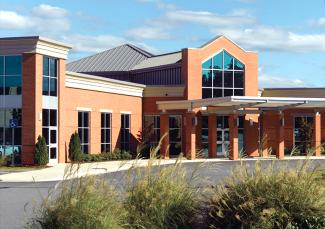Why Do I Need Cardiac Catheterization?
This type of procedure at AnMed Medical Center can help your doctor:
- Look for blocked or slowed blood flow in heart arteries
- Check the health of your heart valves
- Measure pressure in your heart chambers
Your doctor may also use a heart catheter to perform treatments such as:
- Ablation – Stops heart tissue from sending electrical signals that cause arrhythmia (unusual heartbeats)
- Angioplasty – Inflates a tiny balloon in a clogged artery to widen it and restore blood flow
- Aortic valve replacement – Implants a new valve over a narrowed one to treat aortic stenosis
- Closure of an atrial septal defect (ASD) – Implants a tiny device that seals off a hole in your heart to relieve stress on the muscle and treat shortness of breath
- Closure of a patent foramen ovale (PFO) – Implants a tiny device to seal off a hole in your heart that led to a stroke
- Pulmonary embolism treatment – Dissolves a blood clot in your lungs to relieve symptoms of heart failure and shortness of breath
- Valvuloplasty – Opens a narrowed heart valve
Preparing for Cardiac Catheterization
You may get blood tests or cardiac tests to ensure your heart is healthy enough for your procedure. The night before your catheterization, you’ll need to stop eating and drinking so your stomach is empty. Your doctor may also tell you to stop taking certain medications for a short time. Follow all your instructions carefully to stay safe and make sure your procedure goes as planned.
What to Expect
You’ll go to a cardiac cath lab—a hospital area with the tools and technology for your procedure. You’ll receive sedation to make you relaxed, but you’ll stay awake during the procedure.
A doctor called an interventional cardiologist will most likely insert the catheter into your femoral artery, a large blood vessel in your upper thigh. But if the catheter is placed in your wrist’s radial artery, you’ll recover earlier and go home sooner. Ask your doctor if you qualify for this technique, called the transradial approach.
Your doctor may also inject a special dye into your arteries to make them show up better on a large monitor in the cath lab. The cardiologist uses this monitor to guide the catheter through your blood vessels.
During the procedure, you may be asked to hold your breath, take a deep breath, cough, or move your arm. Your doctor will measure what happens in your heart each time.
Your procedure may take 15 minutes to an hour.
Recovery After Cardiac Catheterization
Expect to spend up to a few hours in a recovery room as your sedation wears off. You may notice bruising or pain when the catheter was inserted, but your symptoms will fade. Most likely, you’ll return home the same day. Your doctor may advise you to take it easy for a week.
You’ll schedule a follow-up appointment in a few weeks, depending on your specific procedure. Call your doctor sooner if you experience symptoms such as:
- Chest pain or shortness of breath
- Unusual heartbeats or skipped beats
- Redness, bleeding or discharge at the incision site
- Dizziness or more fatigue than usual
- Chills or fever
- Numbness, coolness or blue color in your arm or leg
Cardiac Rehabilitation
Your cardiologist may refer you to cardiac rehabilitation after catheterization, especially if your procedure treated a serious illness. Rehabilitation helps you safely regain strength and stamina with personal guidance from caring exercise specialists.
